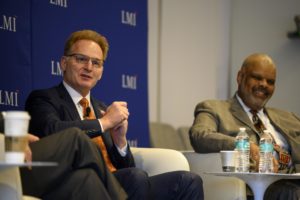Acting Secretary of the Navy Thomas Modly said he asked service officials looking at the future force structure to focus more on 10 versus 30 years out as the Navy plans to release its next Force Structure Assessment in the coming weeks.
Speaking at a National Defense Industrial Association event Friday, Modly acknowledged the 355-ship Navy was something President Trump ran on and Congress subsequently put into law as a goal.

“But we haven’t made a lot of progress in terms of understanding what that is, what it should look like. And so every plan that we’ve had over the last couple of years had this very ephemeral goal out there 30 years from now that we’ll get to that force,” Modly said.
Modly compared current thinking on what is needed in 30 years to a Naval War College Review article he wrote in 1984 on the South China Sea and Japan’s responsibility to protect sea lands around it.
“There’s not a single mention of China in that article. It’s all about Russia. So I don’t know what the threats are going to be 30 years from now, but if we’re building a force structure for 30 years from now, I would suggest we’re probably not building the right one,” he continued.
Modly said given that idea he asked Navy officials to take the 30-year goal and pull it back 20 years to see what the force structure should be like in 10 years.
“So we’re working on that, it just makes it more real, helps us understand what type of trajectory we should be on,” he said.
Once the Navy figures out what is needed in 10 years, that determines what ships and platforms are needed and consequently what kind of people you need, where should you base, how to ramp up the industrial base, and what kind of weapons to carry, Modly added.
Last month, Chief of Naval Operations (CNO) Adm. Mike Gilday noted the upcoming Navy FSA will be an integrated model with the Marine Corps and it would be updated annually (Defense Daily, Dec. 6).
While the CNO said he did not know what the future force would be like, beyond current and planned ships, he was agnostic about how to mix in unmanned vessels and thinks the fleet is currently too small with capabilities stacked on too few ships that are too big.
Gilday noted said 75 percent of the current fleet will be in the fleet of 2030, “so we have to think about how we get more out of it.”
At the Surface Navy Association symposium earlier in the month, Gilday added the FSA will not count unmanned vessels in the total battle force ship count (Defense Daily, Jan. 15)